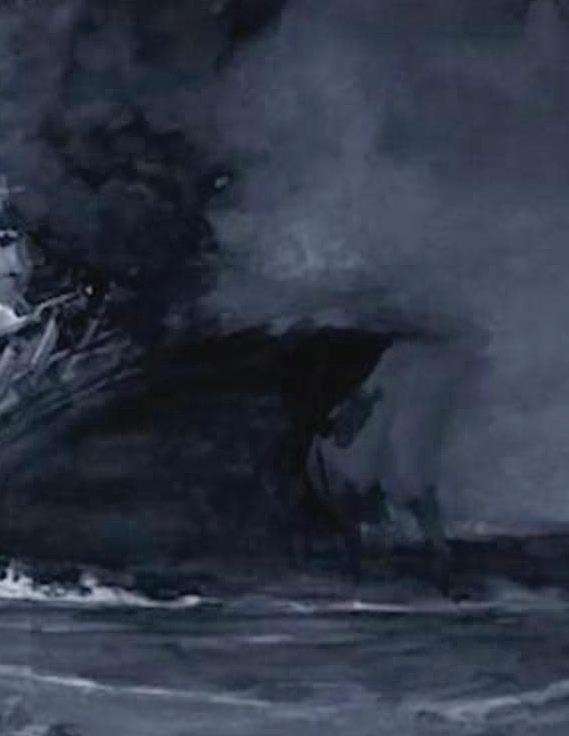
4 minute read
History and Heritage
USS Indianapolis: Supreme Success and Sacrifice
By Commander, Naval Surface Force, U.S. Pacific Fleet Public Affairs
Advertisement
The last major U.S. Navy ship sunk in WWII, the cruiser delivered the final blow that ended the war. 75 years later, they’ve left a legacy of a free and open IndoPacific.
After earning ten battle stars for heroics over four years of war, the U.S. Navy cruiser USS Indianapolis (CA 35) had just successfully delivered the bomb parts that would finally bring to a close WWII.
Days later, on July 30, 1945, and barely a month from the end of the war, she was sunk by an enemy submarine returning from her top secret mission. More than 880 of the ship’s 1,196 Sailors and Marines went into the water.

After more than four days of exposure, drowning, and shark attacks, only 316 survived.
On behalf of all Sailors, past and present, I want to express my deepest gratitude for the service and sacrifice of the crew of USS Indianapolis," Chief of Naval Operations (CNO) Adm. Mike Gilday said during a video address honoring the ship's crew. "During our nation's darkest hour, they dared everything and went into harm's way again and again. We will always remember their valor in battle and the role they played in ending the most devastating war in history.
Today eight crew members remain. The youngest are 93 years old.
While the ship’s final act has made her the subject of enduring public interest, it was her remarkable success in battle that made her and her crew legends.
The flagship of the 5th Fleet, USS Indianapolis served in the Pacific during WWII -- from responding to Pearl Harbor to Alaska to Tarawa to Saipan to Iwo Jima right through until her final, successful albeit tragic final mission. She earned ten battle stars for: - Bougainville Air Action (20 February 1942) and the Salamaua-Lae Raid (10 March 1942) - Aleutians Operation (Attu Occupation) (25 May-3 June 1943) - Gilbert Islands operation (20 November-8 December 1943) - Marshall Islands operation, including the occupation of Kwajalein and Majuro Atolls (29 January-8 February 1944) and the occupation of Eniwetok Atoll (17 February-2 March 1944) - Asiatic-Pacific Raids, involving Palau, Yap, Ulithi, and Woleai (30 March-1 April 1944) - Marianas operation, involving the occupation of Saipan (11 June-10 August 1944), the Battle of the Philippine Sea (19-20 June 1944), and the capture and occupation of Guam (21-23 July 1944) - Tinian Island Capture and Occupation (24-25 July 1944) - Southern Palau Islands apture and Occuaption (6 September-14
The U.S. Navy remains vigilant, and is committed to sustaining a free and open Indo Pacific that the men of the USS Indianapolis and those like them sacrificed to ensure.
In today’s Great Power Competition, U.S. military members recognize they must be ready to fight and win when called. The men of USS Indianapolis set the standard today’s service members strive to honor.
The USS Indianapolis’ proud legacy continues today. On October 26, 2019 the nation commissioned the current USS Indianapolis (LCS 17), a littoral combat ship homeported in Mayport, Florida. The ship’s motto “Legacy of War” reflects the ships named Indianapolis have served in World War I, World War II, and the Cold War. LCS 17 is the fourth ship to bear the name. October 1944)


- Iwo Jima Operation (15 February-6 March 1945), Fifth Fleet raids against Honshu and the Nansei Shoto (15-16 February, 25 February, and 1 March 1945) - Okinawa Gunto Operation (17-25 March 1945) and the assault and occupation of Okinawa Gunto (26 March-5 April 1945)
The ship’s location had been a mystery until August 18, 2017, when naval historians and the Research Vessel Petrel teamed up and discovered the remains in the Pacific at a depth of nearly three and a half miles (5,500 meters).
“Dad would have been amazed at the incredible images of Indy captured by the crew of Petrel. He always said though that if the ship was found, the site should be kept a sacred place to honor the memory of his shipmates who were lost,” said Peggy Campo, whose father, Donald C. McCall, served on the ship for two years. While assigned, the ship earned eight of its ten battle stars. He died in June 2017 at the age of 92, only weeks before the wreckage of
the ship was discovered.
LCS-class ships allow the Navy to strengthen its partnership with other countries’ navies and coast guards. They perform maritime security operations, theater security cooperation engagements, and freedom of navigation patrols – keeping critical maritime commerce routes open. Littoral combat ships are able to patrol the littorals and access ports where other ships may be unable.
Americans should forever remember the crew’s remarkable success in battle, and honor the service and sacrifice of the ship’s Sailors and Marines. *










